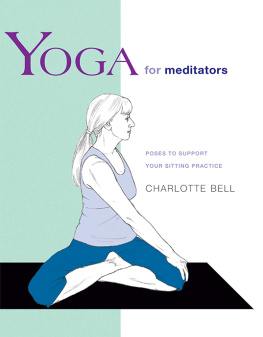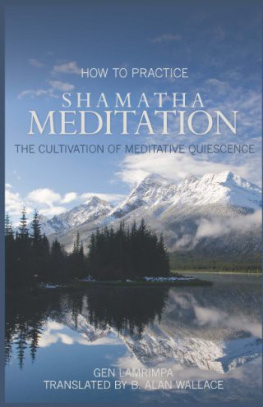Table of Contents
ACKNOWLEDGMENTS
THIS BOOK EMERGED primarily from my personal experience during a ten-month meditation retreat in 2004 at the Forest Refuge at the Insight Meditation Society, in Barre, Massachusetts. There is, however, little in this book that can be credited only to me.The lessons, stories, techniques, and teachings contained in this book are one reflection of a lineage of generosity that extends beyond my personal exploration. The contents reflect the influence of many teachers who have shared their wisdom and guided me through difficult lessons as I struggled to develop my mind and understand the nature of things. Most notably, Christopher Titmuss unwavering encouragement over more than twenty years has challenged me to trust the liberating potential of the Buddhas teachings, even when it feels inefficient, inconvenient, and unpopular to do so. My guru, the late H.W.L. Poonja, revealed a depth of clarity, timeless and pure. Although nearly a decade has passed since his death, he continues to serve as my compass to truth. I have great appreciation for the dedication of the many teachers at the Forest Refuge who guided me during fourteen months of jhana-based practice, especially Myoshin Kelley, Joseph Goldstein, Amita Amy Schmidt, Sarah Doering, Michelle McDonald, Venerable Pa Auk Sayadaw, and Venerable U Jagara. I am grateful to all my teachers, each of whom offered an insight here or there, a challenge to overcome, or a moment of encouragement that kept both my practice and this book developing during the years of its formation.
I am grateful to the community of Insight Meditation South Bay in Mountain View, California, and the many people whose generosity made it possible to spend a year in silence.The support of so many friends and students provided a wellspring of energy that carried me through the more demanding moments of retreat and sustained me through many drafts of this book.
With deep gratitude for their generosity and encouragement, I thank: Betsy Currie, Chade-Meng Tan, LeAnn Bjelle, Glenn Smith, Woods Shoemaker, Adam Winkler, Mikaela and Craig Barnes, Nancy Holt, Rachael Belash, Ron Paisley, Greg MacDonald, Michael Wilding, Shirley Kwok, Steve and Shari Gaber, Jack Erwin, Janet Taylor, Steve and Cheryll Gasner, Edy Young, Drew Oman, Ed Haertel, Doug Slakey, Christine Davis, Jim Podolske, Mary Roy, Maureen OBrian, Doug Forehand, The Farrah Family, Michael Choy, Gordon Mitchell, Wynette Richards, Joan Mitchell, Linda Rohacek, Richard Sievers, Ellen and David Sugarman, Fred Herman, Lisa Grinnell, Jon Viscoli, Michelle Downs, Meryl Landy, Susan Atwood-Stone, Zina Daniels, Linda Drucker, Sandra Hahn, Brian Bush, Kate Sladen, Elizabeth Romero, MaryJo Whiteman, Mark Graves, Lawrence Tharp, Sue Lucksted, Barbara Byron, Lydia Succi, San Jose Sangha, Arlene Noodleman, Suzanne Kryder, Bobbi and Pat Culbert, Ellen Miller, Cleve and Diana Pardue, Pat White, Laura Crabb, Winifred Hegarty, People of Color Sangha of Albuquerque, Mike Kupfer, Lois Gerchman, Maureen Christine, Jerry Parks, Bill Buchholz, Barbara Vana, Alexcia Trujillo, Smita Joshi, Nathan Williams, Joan Granger, Deborah Hill, George Schroeder, Cassidy Trager, Ed Morgan, and Michelle Goodman.
Transmitting an inner meditative experience into a practical manual required the assistance of many friends and editors. Several friends guided me through the writing process by reading early drafts and sharing skills, suggestions, and questions.This book could not have taken shape without the thoughtful reflections and continuous encouragement of Pat McClelland,Terry Farrah, Lila Kate Wheeler, Glenn Smith, Koelle Bodhi, Dianna Eden, Keren Arbel, Stephen Fulder, Sharon Small, Amita Amy Schmidt, and Leigh Brasington, as well as the contributions of Barry Boyce, whose skillful editing sculpted the final version of this book.
I am especially grateful to Wisdom Publications and my editor, Josh Bartok. Joshs vision and enthusiasm brought this project to life, while his many helpful suggestions and precise corrections clarified subtle points in the text. Books are created through countless unseen contributionsI deeply appreciate the team at Wisdom Publications for their full commitment to this project.
And finally, the truly essential and pervasive support may be the most difficult to distinguish.The love of my family is present as a backdrop to who I am and what I do in the world. My mother, Elizabeth Tromovitch, my sister, Lisa Tromovitch, and my brother, Philip Tromovitch, have given me the greatest of all forms of supporttheir unfaltering trust, interest, and love. Even when my explorations have drawn me to unfamiliar religions across the globe, or separated me through prolonged periods of silent retreat, I have felt the presence of my familys unlimited love.This is a treasure and blessing that I cannot measure or repay.
INTRODUCTION
From Focused Concentration to Fearless Awakening
RESTING UNDER THE SHADE of a rose apple tree, the young Siddhartha Gotama (whom we would later come to know as the Buddha) spontaneously entered a state of deep concentration, satisfaction, and ease. Much later, after he had studied intensively with two meditation masters and practiced extreme asceticism, he recalled that quiet moment in his youth. Now emaciated by years of rigorous fasting, Siddhartha Gotama was startled by the recollection. After pondering it awhile, he decided to cultivate those naturally pleasant states as the means to awakening. In so doing, he harnessed the potency of the unified mind and transformed a conventional practice of concentration into a catalyst for awakening, for enlightenment. Austere practices of self-mortification understandably lost favor as he taught his disciples to unlock the power of a happy mind.
This meditative technology of intense concentration that leads to sublime states of mental absorption, known as jhana, predated the Buddhabut since he was able to use it as a foundation for his enlightenment, it became a critical feature of his teachings. The practice of using jhana as a basis for insight has been preserved to this day. In the discourses of the Pali Canon, the earliest records of the Buddhas teaching,concentration appears repeatedly and is taught as a pivotal method for inner transformation. In Pali, jhana literally means to think or to meditate. Consequently, the term is open to a wide variety of uses and interpretations and there has been much debate about its precise meaning. In this book, jhana practice refers to a traditional sequence of specific states of absorption where the mind is secluded from sensory impingement and deeply unified with a chosen object. Attention is not distracted by stray thoughts nor affected by the flutter of moods. Even physical sensations and sounds eventually fade as the mind becomes entirely immersed in a single coherent focus.
Jhanas are states of happiness that can radically transform the heart, reshape the mind, imbue consciousness with enduring joy and ease, and provide an inner resource of tranquillity that surpasses any conceivable sensory pleasure. Jhanas are states of deep rest, healing rejuvenation, and profound comfort that create a stable platform for transformative insight. Throughout the development of jhana, we intertwine the calming aspects of concentration with the investigative aspects of insight meditation. The fruit of concentration is freedom of heart and mind.











